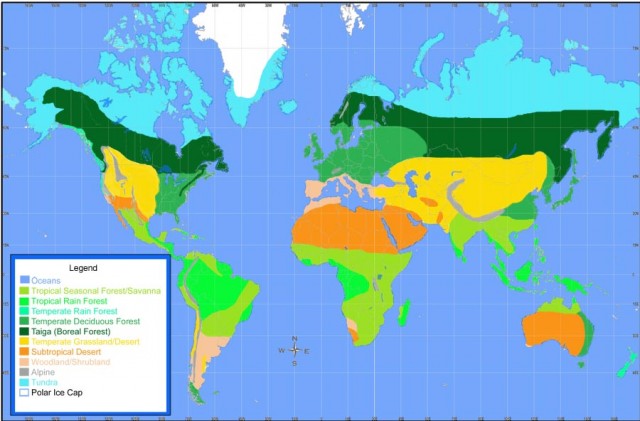Biome
A BIOME IS A classification of large areas of plant formations. The world's vegetation communities can be described in many ways depending on scale and controlling factors. The early plant geographers, notably F. E. Clements and V. E. Shelford, working in the UNITED KINGDOM and the UNITED STATES in the early 20th century, defined and classified the major plant formations with their associated fauna as biomes. Within each biome, there is a uniform life form of vegetation, for example, FORESTS and GRASSLANDS in which trees and grasses predominate respectively. All biomes are extensive and characterize large areas of the Earth's surface. Further subdivisions are possible; for example forests can be divided into coniferous, temperate, and tropical, and grasslands may be temperate or tropical. These subdivisions are usually linked with the prevailing climate because the annual temperature and precipitation regimes are important determinants of vegetation life form and species composition, which, in turn, influence animal communities. Thus, in traditional terms biomes are climatic climax communities, that is, they comprise plant and animal communities that have developed an equilibrium with their environment which facilitates definition as a unit.

There are rarely sharp boundaries between biomes but rather a gradation in a transition zone, similar to an ecotone, or boundary between ECOSYSTEMS, which can also be synonymous with biomes at the global scale. The major biomes recognized on the Earth's land surface include the following:
- TUNDRA: High latitudes, no trees, dwarf shrubs, herbs, grasses.
- Forests: Taiga (coniferous forest) in high latitudes, evergreen tree species predominate; temperate forest: temperate latitudes/high latitude maritime, broadleaf species; temperate RAINFOREST: same as temperate forests above, especially Southern Hemisphere island locations, evergreen and broadleaf species; tropical forest: tropical latitudes with high rainfall, varied composition with evergreen and broadleaf species.
- Savanna: Various types depending on tree/grass distribution, tropical latitudes with seasonal rainfall, grasslands to open forests.
- Mediterranean-type: Sometimes described as chaparral, various types in areas of hot, dry summers and warm, wet winters, between temperate and tropical latitudes; mixed woodland, grassland, shrubs.
- Grasslands: Various types, mid-latitude continental interior with a wide annual temperature range, grass species predominate.
- DESERT: Highly variable, depending on precipitation volume and distribution, low latitudes with low rainfall, few trees and shrubs, ephemeral herbs and grasses, includes succulents.
Aquatic environments can also be classified into biomes, notably wetlands, freshwater environments, and marine ecosystems. The first two categories can be further subdivided depending on characteristics such as climate, acidity, alkalinity, and salinity. Marine ecosystems can be subdivided into two units: the LITTORAL or shoreline zone and the oceanic or open water zone. Examples of littoral ecosystems include mangrove swamps and salt marshes. The oceanic zone also varies roughly on a latitudinal basis reflecting water temperature and, hence, the prevailing climate.
An alternative classification can be applied to the vertical distribution of marine organisms, namely, the illuminated or photic zone near the surface, where light allows photosynthesis to take place; the nectonic zone, in which fish and aquatic mammals live; and the ocean floor, which may be rock, sand, or mud, where bottom- dwelling organisms (benthos) live.
The distribution and composition of biomes are not constant in geological time. Throughout the 5,000 million years of Earth history, changes in climate and earth movements have altered the configuration of the continents and the oceans. Evolution has given rise to new life forms. The most geologically recent alterations to the world's biomes occurred during the last 3 million years, the last Ice Age, when a series of cold periods (glacial stages) separated by warm (interglacial stages) began.
As temperatures waxed and waned, the world's biomes changed in extent and in composition. The biomes described above came into existence between 10,000 and 5,000 years ago during the current interglacial stage. The present biomes have also been substantially modified by human activity for which there is no precedent in earlier geological periods. The biomes contain a wealth of natural resources that have sustained humankind and allowed the species to proliferate, but at a cost. Agriculture, mining, logging, pollution, urban spread, tourism, and water extraction are all contributing to ecosystem loss and species extinction.
This alteration is also impairing the capacity of the biomes to provide essential services such as the circulation of elements and compounds between the atmosphere, vegetation, and soils, as in the carbon and nitrogen cycles. This is related to the regulation of climate as vegetation, especially trees, provide a huge store of carbon. But as deforestation occurs, increasing volumes of carbon enter the atmosphere as carbon dioxide and so exacerbate the problem of global warming caused by fossil-fuel consumption.